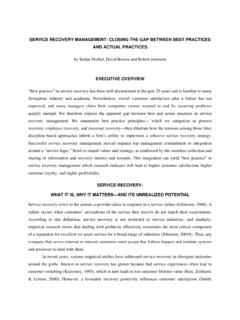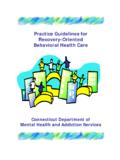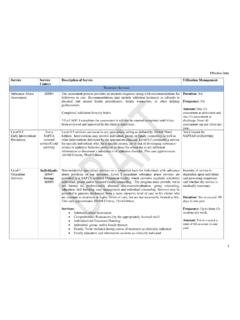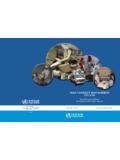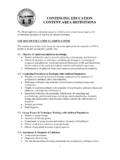Transcription of SERVICE RECOVERY MANAGEMENT: CLOSING THE …
1 SERVICE RECOVERY management : CLOSING THE GAP BETWEEN BEST PRACTICES AND ACTUAL PRACTICES Stefan Michel Assistant Professor of Marketing Thunderbird, The Garvin School of International management Global Business Department 15249 N 59th Avenue, Glendale, AZ 85306 T +1 (602) 978 72 96, F (602) 843 61 43, E David Bowen Robert and Katherine Herberger Chair in Global management & Professor of management Thunderbird, The Garvin School of International management Global Business Department 15249 N 59th Avenue, Glendale, AZ 85306 T +1 (602) 978 70 37, F (602) 843 61 43, E Robert Johnston Professor of Operations management Warwick Business School University of Warwick, Coventry, CV4 7AL, UK T +44(0 )2476 524218 F +44 (0) 2476 572583, E 10/8/2006 SERVICE RECOVERY management : CLOSING THE GAP BETWEEN BEST PRACTICES AND ACTUAL PRACTICES EXECUTIVE OVERVIEW SERVICE RECOVERY refers to the actions companies take when they have failed to provide the SERVICE customers expected, which makes it relevant for managers in any industry or organization that provides some sort of SERVICE to external or internal customers.
2 Although the positive impact of SERVICE RECOVERY on satisfaction, loyalty, and recommendation has been well documented empirically, evidence suggests that SERVICE RECOVERY practice has not improved. Effective SERVICE RECOVERY management requires a cross-functional approach that takes a marketing perspective (customer RECOVERY ), a management perspective (employee RECOVERY ), and an operations perspective (process RECOVERY ). By studying the three main RECOVERY approaches in a variety of industries and countries, the authors identify eight hurdles that must be overcome to close the gap between actual and best practices and suggest how to do so. THE GAP BETWEEN BEST PRACTICES AND ACTUAL PRACTICES Best practice SERVICE RECOVERY has been well documented in the past 20 years and is familiar to many throughout industry and academia.
3 So why does evidence indicate that many firms do not have SERVICE RECOVERY strategies in place or even attempt SERVICE RECOVERY and that, among those firms that do make the attempt, customers tend to be dissatisfied with their SERVICE RECOVERY efforts [1]? We explore the apparent gap between best practices and actual practices in SERVICE RECOVERY management . We first summarize best practice principles in the literature, then provide incident-based examples of existing gaps, describe the hurdles that cause these gaps, and categorize them into distinct groups. Finally, we offer strategies for how organizations can overcome these hurdles. 2 SERVICE RECOVERY : WHAT IT IS AND WHY IT MATTERS SERVICE RECOVERY refers to the actions a provider takes in response to a SERVICE failure [2].
4 A failure occurs when customers perceptions of the SERVICE they receive do not match their expectations. According to this definition, SERVICE RECOVERY is not restricted to services industries. Empirical research also shows that dealing with problems effectively constitutes the most critical component of a reputation for excellent (or poor) SERVICE for a broad range of industries [3]. Any company that serves external or internal customers must accept that failures happen and institute systems and processes to deal with them. In recent years, numerous empirical studies have addressed SERVICE RECOVERY in various industries around the globe. Interest in SERVICE RECOVERY has grown because bad SERVICE experiences often lead to customer switching [4], which in turn leads to a loss in customer lifetime value [5]. However, a favorable RECOVERY has a positive impact on customer satisfaction [6; 7], word-of-mouth behavior [8-11], customer loyalty [4; 9; 12; 13], and, eventually, customer profitability [14-18].
5 Although some studies show that good initial SERVICE is better than an excellent RECOVERY [19], other empirical work suggests that an excellent RECOVERY can lead to even higher satisfaction and loyalty intentions among consumers than if nothing had gone wrong in the first place [20-22]. This phenomenon is usually referred to as the SERVICE RECOVERY paradox [23]. BEST PRACTICES IN SERVICE RECOVERY The interdisciplinary services literature offers a rich source of research and insights on effective SERVICE RECOVERY . In the following sections, we present some consensually held principles regarded as best practices in SERVICE RECOVERY , structured according to what we introduce as the three types of RECOVERY : customer RECOVERY (reestablish customer satisfaction), 3 process RECOVERY (learn from failures to avoid them in the future), and employee (prepare employees to deal with failures) RECOVERY .
6 Customer RECOVERY Fairness is the key Recent contributions show that perceived justice is a significant factor in SERVICE RECOVERY evaluations [6; 24; 25]. Because a report of a SERVICE failure implies, to some extent, unfair treatment of the customer, SERVICE RECOVERY must reestablish justice from the customer s perspective. Justice consists of three dimensions: distributive, procedural, and interactional [26]. Distributive justice focuses on the allocation of benefits and costs [27] and acknowledges that customers consider the benefit they receive from a SERVICE in terms of the costs associated with that SERVICE ( , money, time). When they do not receive the expected outcome of a SERVICE , they are dissatisfied, which means SERVICE RECOVERY is needed. However, the outcome of a SERVICE is not the only thing that matters.
7 Because customers often are involved in the SERVICE production/consumption process, procedural justice also is key [28], especially when something goes wrong. Thus, employees must fix the customer before they fix the problem [29]. Procedural justice relates to the evaluation of procedures and systems used to determine outcomes [25], such as the speed of RECOVERY [24; 26]. Another factor in many RECOVERY incidents is the information communicated about the RECOVERY process, or the lack thereof [30]. Firms must describe what the firm is doing to resolve the problem so that customers understand mitigating circumstances and do not incorrectly attribute blame to the SERVICE firm when it is not responsible [31]. 4 Finally, interactional justice pertains to interpersonal fairness.
8 People are sensitive to the quality of interpersonal treatment they receive [32], and because emotions tend to be more important than cognitions in RECOVERY situations [33], SERVICE managers need to manage consumers' emotional experience during and after a SERVICE failure [31]. In leading the customer through a negative experience, employees should act quickly; show concern and empathy for the customers; and remain pleasant, helpful, and attentive [17; 34; 35]. Furthermore, customers should be treated as individuals whose specific requests are acknowledged, because token responses by a company resulted in the most vehemently negative responses [36]. All three types of justice contribute significantly to customers evaluations of RECOVERY [1]. In addition, significant interactions among the fairness dimensions mean that poor performance on any one can dramatically limit customers overall satisfaction with RECOVERY .
9 Do not fail twice You will be forgiven, but usually only once. Studies show that SERVICE RECOVERY is likely to work after a single SERVICE failure but not after the company has failed the customer twice [37]. Evidence also suggests that customers evaluate services with a zone of tolerance that frames how much variance they will accept between what they expected to receive in a SERVICE encounter and what they perceive they actually received [38]. Their zone of tolerance narrows from its initial size when they assess the firm s SERVICE delivery to when they evaluate its attempt at SERVICE RECOVERY after a failure. As a result of this narrowing, no RECOVERY strategy can delight the customer if an initial failure proceeds into a RECOVERY failure [39]. This finding has been supported by a longitudinal study that indicates a RECOVERY paradox such that customers are even more delighted after an effective SERVICE RECOVERY than if the SERVICE was failure-free in the first place can occur after one failure, but no such outcome is possible after two failures.
10 5 RECOVERY efforts become even more challenging, and even impossible, when two similar failures occur, especially in close time proximity [12]. Accept that only the customer knows the true extent of the failure Best practices in SERVICE RECOVERY demonstrate the need to assess failure magnitude, severity, or criticality [40; 41] not from the company s perspective (what did we do wrong?) but from the customer s (what consequences does the SERVICE failure have for them?). An interesting experiment illustrates the difference: In a car repair scenario, a car is not ready at the time promised [40]. The respondents in the experiment experienced either a low criticality or a high criticality situation.

